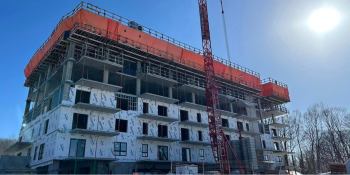Q&A Forums
Spray Foam - No Energy Savings - Little Benefit Post New Topic | Post Reply
| Author | Comments |
|---|---|
|
Jason Fowler
Posted: Jul 17, 2010 08:50 AM
|
Spray Foam - No Energy Savings - Little Benefit
Two years ago I had approximatley 5" of open cell applied between the rafters and a lesser amount applied to the edges of the rafters for complete coverage. To date I've seen no reduction in utility costs. I know this is a broad question with many possible explanations but I thought I would give it a try. Why am I not seeing and $$ benefit from my investment? 5 year old home Concrete foundation, single story, brick exterior, shingle roof. approx. 3000 sq. ft. under beam, 54 squares of roofing Attic floor originally insulated with blown insl. Gas Water Heater and Furnace in attic Attic floor almost completey decked Pull down attic stair located in garage At 1st there were no changes to the above configuration. After several months of disappointing results I started to make the following changes Enclosed water heater and added dedicated ventilation from outside Sealed the furnace combustion section and ran dedicated ventilation directly into the combustion compartment Added weather stripping to attic stair door Removed approximately 70% of the original blown insulation from the attic floor Combed 80% of the perimeter of the roof line where rafters meet joists and used spray can foam to fill voids left by contractor As always we keep the house approximately 72F when occupied and the unit off when away. The attic temp drops to upper 70's by 10 am and then climbs to upper 80's by 3 pm, continues to climb to mid 90's until 8 or 9 pm then starts to decend to upper 70's by mid morning the next day. Obviously foam isn't magic and not a cure all for all issues, it's part of a system that has to work. I think the house is built to industry standards. I think I have a sufficient amount of product and have corrected a great deal of the deficiencies left behind by foam contractor. I plan to remove the remaining blown insulation an seal any remaining cracks I find where the rafters meet the joists, but to date none of the one's mentioned have reduced energy consumption. Am I getting all I am going to get from my foam and my problems are else where. It just doesn't make sense, where are all of the advertised energy savings? The 3-5 year pay back? etc. My attic is definatley cooler than it used to be so now my christmas decorations are more comforatable but that's not the real reason I made the investment. I'm in the HVAC business so I feel that I have at least an average understanding of building science and the systems that make up a house, hopefully your repsonse will uncover something I missed, thanks. |
|
mason
Posted: Jul 17, 2010 02:39 PM
|
I was crunching some numbers on the expected energy usage of your home based on the original insulation application and what it is now. You say the energy costs are the same. I presume you mean the energy usage is the same. Utility rates are higher now than they were 2 years ago in most places. But to get to your situation. I assume that the original insulation application was somewhere around 10 to 12 inches of blown in cellulose or fiberglass for an R value of between 30 to 38. The R value of the 5 inches of open cell foam would be around R 18 to 18.5. It looks like to me that the open cell foam is performing at a 35% greater energy performance when you compare the relative R values of the products. But since your intentions were to get better energy performance than before, it would have been better to install a greater thickness of foam. R 18 is not quite enough to give you the maxiumum energy efficiency. Another couple of inches most likely would have made a large difference. |
|
Jason Fowler
Posted: Jul 17, 2010 05:26 PM
|
Mason, thank you very much for your repsonce however I'm having trouble following you. It's hard to say what the orignal depth was but it did cover all of the joists and they range from 2x6's in smaller areas to 2x12's in larger rooms and all of the joists were covered so it was at least 8" through out. I agree that inch for inch the foam is performing better than the blown but isn't that the idea? Are you saying that the insulation that I originally had was more insulation than the average house and by replacing it with foam meant I needed more foam than the average house. I was under the impression that 4" on the underside of the roof was typical industry standard and 4" under the roof would out perform the typical blown insulation on the attic floor. I wasn't aware that people are putting 7" under the roof. |
|
John Shockney
Posted: Jul 17, 2010 10:24 PM
|
Here in Indiana we spray 8 to 10 inches of open cell on the underside of the roof to get an R-35 to R-38 as required by code. The cellulose guys are blowing in 12 inches or more to get the same performance. Also we only recommend foam sprayed on the underside of the roof when there is duct work or mechanicals in the attic, if there aren’t any then we would recommend the blown in cellulose insulation do to lower cost per R-value. But the bottom line is that you can’t expect energy savings with a lesser thickness of open cell foam than the blown in cellulose when the air spaces inside the insulation is what provides most of the insulation value in either material, we also spray 5 inches of closed cell for an R-35 on the underside of the roof. Hope this helps Airpro |
|
Jason Fowler
Posted: Jul 18, 2010 03:34 PM
|
Thanks Airpro, any input is welcomed. So far we have 2 votes for too little product which is a bit surprising as I was under the impression that 5" was about the point of diminishing return for OC foam. I'm prettty sure I've read that more than once. I understand the concept of the air within the insulation providing the insulating effect however the stagnet trapped air in a few inches of foam should far outperform the potentially flowing air within several inches of fiberglass hence the apples and oranges comparison of the 2 products and the whole debate over the real value of "R-Value". Perhaps I'm missing the forest for the trees and looking for something way more complicated than what the real problem is. I'll admit that the thought of more product has crossed my mind however at the going price of 5" adding 40% more product to get it to at least 7" doesn't seem like it works out economically. It would take over 10 years to pay back, if that soon. Who would buy into that? |
|
Cory Boehs
Posted: Jul 18, 2010 03:45 PM
|
I guess what caught my attention was that you are going around and sealing up gaps in the original foam application. If there is air infiltration you are losing a lot of efficiency with your foam. I have heard the figure if you miss 2% of the envelope, it could lower your total efficiency by 10%. Am I on the wrong track here? Also, I hope the industry standard is more than 4" OC. We try for a mininum of 6" here in NW Oklahoma. |
|
Bryan Kwater
Posted: Jul 18, 2010 07:28 PM
|
After reading both of your posts, I would guess that when you hired a foam contractor, you found someone "real cheap". Usually when someone is cheap, there is a reason. You should not have had to fix voids left by the contractor and if installed correctly foam will not smell. (Installed off ratio?) The voids along with the insufficient foam thickness are the primary reasons why the system is not performing as it should. Here in Michigan the code calls for R-49 on the ceiling or roof deck. That is significantly more than the R-18 that you have. More is always better. A contractor that takes his time and makes sure things are sealed up correctly makes a huge difference. I would recommend having a couple different foam contractors assess your situation and give their input. Most good installers will spot the problem areas very quickly. It's hard for anyone to tell you what the problem is for sure unless they see it in person. |
|
Edward Brassington
Posted: Jul 18, 2010 09:39 PM
|
I also agree that you do not have enough foam.The R value of open cell foam is approximately R3.5 per inch depending on the brand. It sounds like you only have about R15- R18. What are the actual code requirements for your area. I assume that the foam was sprayed on the underside of the roof. If the foam is on the attic floor, then maybe have cellulose blown over the foam to increase the R value. Try to find somebody with a thermal imaging infra red camera. A scan of the foam will tell you pretty quickly if there are any voids in the foam. Locate an area of the foam that has exactly 5 inches of foam, determine the exact temperature of that spot and then use that as a benchmark for the rest of the attic. Many restoration companies and home inspectors are now using thermal imaging cameras. They are a great tool. You can also detect voids by lightly tapping the foam with the back of your hand. There is a certain bounce when there are no voids, the foam reacts differently when voids are present. |
|
Posted: Jul 19, 2010 07:08 AM
|
put me in the 2 little product list... you cant put in half as much and promise twice as much... now we have real world experience to show that a 6-8 lift of oc will perform just fine,,meaning no ice dams,,and "decent" thermal performance,,,but this r25 or there abouts application will "perform" like the r40 filterglass system it replaced,,and this is what you are seeing it sounds like.. i prefer a 12" lift of the r4.2/" product we apply to get us closer to the r49 energy star number for zone 5,,,and these structures do operate more efficiently than the r49 filterglass applications next door.... i get "underbid" by newbee hillbillys makeing the "6" is enough recommmendation" quite regularly nowadays with the market saturation of 1-gun-wonders,,,and if i dont get a chance for rebuttal,,to refute and educate,, i will loose the job,,,and the contractor will never use spf again due to his disappointment with the performance outcome.. you dont talk about the "cubic foot of conditioned space" added to your hvac systems demands by adding this attics conditioned area to your system...there is a great article in the spfa.org mag about when to condition lid and when to apply to drywall...thinkin about the "doubleing" of conditioned space added with the hot lid application in those 6:12 or better lids,,,phyics is phizzics,,,or so i been told... as a sidebar...we can apply an r25 to the conditioned lid and meet "energy audit" here in the liberal republic of johnson county....this is done with "performance testing" and load calculations by our freindly neighborhood heers rater...so you can put in half as much and expect equal perforamance,,,foam:filterglass,,and our code officials acknowledge this as fact.. most of my customers want "increased performance" and less operating expense,,and this is what it takes to pay down the upgrade.. spray another 6" oc on the lid,,heck with the attic decked it would be a cakewalk... dude :) |
|
mason
Posted: Jul 19, 2010 08:03 AM
|
I made an assumption on the original blown in insulation thickness being installed in accordance with the 2003 IRC insulaton requirements which call for an R value of 38 in attics in mixed and northern climates. This was the amount of insulation in my town home in Virginia that was built in 1994. I removed the 10-12 inches of blown in fiberglass from the floor of the attic and replaced it with 3.5 inches of closed cell foam followed by 1.5 to 2 inches of blown in cellulose (for an ignition barrier). My energy usage dropped around 20% following the foam application. 2 years later I replaced the AC and furnace, reduced the AC from a 2.5 ton to a 2 ton unit and reduced the BTUs by 3500 on the furnace. Energy usage dropped another 15%. So in my case replacing R 38 of blown in fiberglass with R 25 or ccSPF and cellulose resulted in a savings of around $600 per year and I paid $4500 for the foam installation. But the best part in my opinion is the comfort level of the house. Before I had a 8-10 degree temperature swing from the basement to the top floor. After the foam installation the temperature differential was from 2 to 3 degrees. To get a comparative R value of the open cell foam to the closed cell foam application I had, you would have to install 6.5 to 7 inches of foam. As the other readers noted, small gaps in the foam insulation can make huge differences in your energy usage. Make sure the foam is installed correctly and doesn't have significant voids or gaps. For example, the SPFA tested foam sprayed in attics at Oakridge National Labs. Both performed 20 to 40% better than blown in fiberglass even at lower R values. But the open cell foam did not perform as well as the closed cell foam. (15% difference in performance). When the open cell foam was removed from the test chamber, many voids and wormholes were found in the insulation. We assumed this made up the difference in performance. I agree with the reader who suggested an infra-red scan of the building to determine where the gaps and voids are. |
|
Jason Fowler
Posted: Jul 19, 2010 02:09 PM
|
Great responces, thanks to all. As for voids in the foam I was in the attic when this was done (all 3 times, it took that many try's to get the thickness) and although the installers were amateurs I do think the the material is solid. Someone mentioned a few small leaks at the eves making a big differnce in performance, if someone else could chime in on that subject it would be great. I plan to continue to seek out and fill every last crack I can find. How about the penetrations through the ceiling? Once the lid is absolutely sealed should I seal all ceiling penetrations or leave them as is as a means for air to circulate from the attic to the house for the semi-conditioned effect? If the product thickness turns out to be the real issue can I apply a different product over what's there? |
|
andy buff
Posted: Jul 19, 2010 05:10 PM
|
ezrizer where are you located |
|
Jason Fowler
Posted: Jul 19, 2010 09:55 PM
|
New Orleans |
|
Edward Brassington
Posted: Jul 19, 2010 10:37 PM
|
From an energy point of view, I don't think you need to be too concerned with sealing the air leakage into the attic from the conditioned space. After all the attic is now part of the conditioned space. Definitely, you want to make sure leaks to the unconditioned space are sealed. You should be able to add a closed cell foam over the open cell foam as long as there is a solid bond between the existing foam and wood structure. Alternatively you could add a reflective rigid foam board to the underside of the rafters. Another option is to have the attic floor insulated with dense pack cellulose, this could help to reduce the heat loss/gain from the attic. |
|
Jason Fowler
Posted: Jul 22, 2010 07:43 AM
|
I didn't think closed over open or visa versa was a good idea, nor is having 2 thermal barriers (roof and attic floor). After studying the install there is a lot of inconsistancy in depth, 4" - 7". As a side note I see as much as 5-6F differnece in surface temp between the low spots and high spots. How about touch up kits to go around and hit the lower spots? I really don't want to go through the mess and agrivation of getting a crew up there again. I was thinkg ing of starting with the westward facing roof panes as they seem to be the hottest. |
|
mason
Posted: Jul 22, 2010 10:52 AM
|
I have to agree that closed cell over open cell is not a good idea. Small touch up foam kits are OK assuming that there are small areas to do and not whole wall sections. |
|
Jason Fowler
Posted: Jul 22, 2010 08:01 PM
|
Is that an economic or performance recommendation? The foam seams to be pretty thick 6-7" as you get closer to the rafters however the very center seems to be the shallowest (4-1/2" avg.)part in quite a few areas, although not always the entire length of the rafter My thought was to run down the centers or where there are shallow spots, with the touch up kits and try to even it out (6-7") as much as I can. With all of the irregularities at this point I though perhaps the smaller kits would allow me better control and allow me to put the foam where it will do the most good as opposed to blasting everything. Also, what about the penetrations through the ceiling, with the unvented attic, should I seal all of them? or would it be better to let air pass from the living space to the attic? |
|
mason
Posted: Jul 23, 2010 11:30 AM
|
You do not want to stop air infiltration into the attic from the living space in an unvented attic. As for how effective the foam pak units will be. Very hard to say without looking at the job. |
|
jimcoler
I have over 10 years of experience specifying and installing open and closed cell spray foam. I've sold my business but I'm still selling for the new owners and consulting on large and custom specific jobs. I've expanded my knowledge into t Posted: Aug 02, 2010 04:01 PM
|
Sorry, I'm away in Uganda doing a water missions project. Still won't be back in the states until next week sometime which I plan to have a lot of catch up to do on behind work. But my 2 cents, on the situation is that your air leaks at the soffits are causing the temp in the attic to fluctuate with the outside air temperatures/RH. This is typcially the case if the roof isn't sealed to the top of the walls. It also sounds like they left the fiberglass in the attic floor and then sprayed down to it. Air can still pass through the filterglass allowing air in one soffit on one side of the house and out the other side. I've seen this happen on a job we recently got to stop ice damming. I also agree that you should have 6" of foam on the underside of the roof - minimum! So, hope this helps! Jim |
|
Jason Fowler
Posted: Aug 04, 2010 06:54 AM
|
Jim, thanks for the input. Initiially the installers were pointing the gun at the joist/rafter intersection and spraying foam directly into the existing blown fiberglass in an attemp to seal the attic. After the 1st day of this it really bothered me so I went in and rip out everything that I didn't like and had them re-spray those areas and in all other areas remove the blown insulation before spraying foam. I thought this was sufficient but later found many places where I still had air leaks. I've since gone back and plugged all of the little hols with can foam and I'm confident I have 95% of them if not 99%. I did have the actual foam supplier come to the house recently to evaluate the situation and he feels that I have pretty much taken care of all of the little issues and it comes down to a really poor installation, inconsistent depth, cold foam, gaps and cracks (gaps under the roof deck where the multiple layers of foam didn't overlay well). He offered to return with thermal imaging equipment to better ID the offending areas and formulate a game plan to correct. This all occured a couple of days ago, as soon as I make more progress I'll post the outcome. |





























